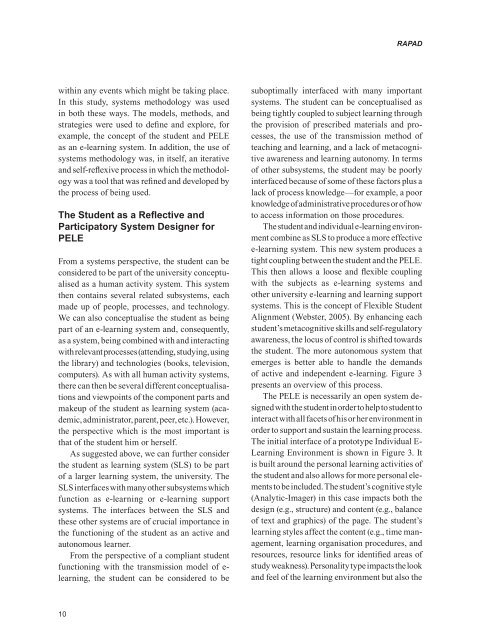Advances in E-learning-Experiences and Methodologies
You also want an ePaper? Increase the reach of your titles
YUMPU automatically turns print PDFs into web optimized ePapers that Google loves.
RAPAD<br />
with<strong>in</strong> any events which might be tak<strong>in</strong>g place.<br />
In this study, systems methodology was used<br />
<strong>in</strong> both these ways. The models, methods, <strong>and</strong><br />
strategies were used to def<strong>in</strong>e <strong>and</strong> explore, for<br />
example, the concept of the student <strong>and</strong> PELE<br />
as an e-learn<strong>in</strong>g system. In addition, the use of<br />
systems methodology was, <strong>in</strong> itself, an iterative<br />
<strong>and</strong> self-reflexive process <strong>in</strong> which the methodology<br />
was a tool that was ref<strong>in</strong>ed <strong>and</strong> developed by<br />
the process of be<strong>in</strong>g used.<br />
The Student as a Reflective <strong>and</strong><br />
Participatory system designer for<br />
PeLe<br />
From a systems perspective, the student can be<br />
considered to be part of the university conceptualised<br />
as a human activity system. This system<br />
then conta<strong>in</strong>s several related subsystems, each<br />
made up of people, processes, <strong>and</strong> technology.<br />
We can also conceptualise the student as be<strong>in</strong>g<br />
part of an e-learn<strong>in</strong>g system <strong>and</strong>, consequently,<br />
as a system, be<strong>in</strong>g comb<strong>in</strong>ed with <strong>and</strong> <strong>in</strong>teract<strong>in</strong>g<br />
with relevant processes (attend<strong>in</strong>g, study<strong>in</strong>g, us<strong>in</strong>g<br />
the library) <strong>and</strong> technologies (books, television,<br />
computers). As with all human activity systems,<br />
there can then be several different conceptualisations<br />
<strong>and</strong> viewpo<strong>in</strong>ts of the component parts <strong>and</strong><br />
makeup of the student as learn<strong>in</strong>g system (academic,<br />
adm<strong>in</strong>istrator, parent, peer, etc.). However,<br />
the perspective which is the most important is<br />
that of the student him or herself.<br />
As suggested above, we can further consider<br />
the student as learn<strong>in</strong>g system (SLS) to be part<br />
of a larger learn<strong>in</strong>g system, the university. The<br />
SLS <strong>in</strong>terfaces with many other subsystems which<br />
function as e-learn<strong>in</strong>g or e-learn<strong>in</strong>g support<br />
systems. The <strong>in</strong>terfaces between the SLS <strong>and</strong><br />
these other systems are of crucial importance <strong>in</strong><br />
the function<strong>in</strong>g of the student as an active <strong>and</strong><br />
autonomous learner.<br />
From the perspective of a compliant student<br />
function<strong>in</strong>g with the transmission model of e-<br />
learn<strong>in</strong>g, the student can be considered to be<br />
suboptimally <strong>in</strong>terfaced with many important<br />
systems. The student can be conceptualised as<br />
be<strong>in</strong>g tightly coupled to subject learn<strong>in</strong>g through<br />
the provision of prescribed materials <strong>and</strong> processes,<br />
the use of the transmission method of<br />
teach<strong>in</strong>g <strong>and</strong> learn<strong>in</strong>g, <strong>and</strong> a lack of metacognitive<br />
awareness <strong>and</strong> learn<strong>in</strong>g autonomy. In terms<br />
of other subsystems, the student may be poorly<br />
<strong>in</strong>terfaced because of some of these factors plus a<br />
lack of process knowledge—for example, a poor<br />
knowledge of adm<strong>in</strong>istrative procedures or of how<br />
to access <strong>in</strong>formation on those procedures.<br />
The student <strong>and</strong> <strong>in</strong>dividual e-learn<strong>in</strong>g environment<br />
comb<strong>in</strong>e as SLS to produce a more effective<br />
e-learn<strong>in</strong>g system. This new system produces a<br />
tight coupl<strong>in</strong>g between the student <strong>and</strong> the PELE.<br />
This then allows a loose <strong>and</strong> flexible coupl<strong>in</strong>g<br />
with the subjects as e-learn<strong>in</strong>g systems <strong>and</strong><br />
other university e-learn<strong>in</strong>g <strong>and</strong> learn<strong>in</strong>g support<br />
systems. This is the concept of Flexible Student<br />
Alignment (Webster, 2005). By enhanc<strong>in</strong>g each<br />
student’s metacognitive skills <strong>and</strong> self-regulatory<br />
awareness, the locus of control is shifted towards<br />
the student. The more autonomous system that<br />
emerges is better able to h<strong>and</strong>le the dem<strong>and</strong>s<br />
of active <strong>and</strong> <strong>in</strong>dependent e-learn<strong>in</strong>g. Figure 3<br />
presents an overview of this process.<br />
The PELE is necessarily an open system designed<br />
with the student <strong>in</strong> order to help to student to<br />
<strong>in</strong>teract with all facets of his or her environment <strong>in</strong><br />
order to support <strong>and</strong> susta<strong>in</strong> the learn<strong>in</strong>g process.<br />
The <strong>in</strong>itial <strong>in</strong>terface of a prototype Individual E-<br />
Learn<strong>in</strong>g Environment is shown <strong>in</strong> Figure 3. It<br />
is built around the personal learn<strong>in</strong>g activities of<br />
the student <strong>and</strong> also allows for more personal elements<br />
to be <strong>in</strong>cluded. The student’s cognitive style<br />
(Analytic-Imager) <strong>in</strong> this case impacts both the<br />
design (e.g., structure) <strong>and</strong> content (e.g., balance<br />
of text <strong>and</strong> graphics) of the page. The student’s<br />
learn<strong>in</strong>g styles affect the content (e.g., time management,<br />
learn<strong>in</strong>g organisation procedures, <strong>and</strong><br />
resources, resource l<strong>in</strong>ks for identified areas of<br />
study weakness). Personality type impacts the look<br />
<strong>and</strong> feel of the learn<strong>in</strong>g environment but also the<br />
0


